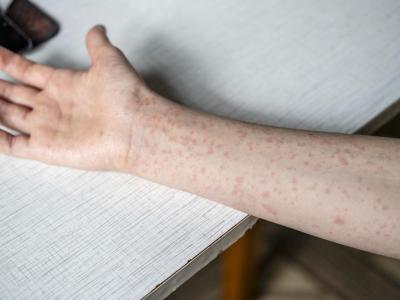Jan 14, 2011 (CIDRAP News) – A team of US researchers reported this week that a set of antibodies derived from 2009 H1N1 influenza patients showed an ability to react with a number of other flu strains, strengthening hopes that it will eventually be possible to create a broadly protective flu vaccine.
The researchers isolated 46 antibodies from nine H1N1 flu patients. Eleven of these were neutralizing antibodies, and 9 of the 11 cross-reacted with multiple flu strains, including previous seasonal H1N1 viruses, the 1918 H1N1 strain, and the H5N1 avian virus.
Further, 5 of the 9 broadly cross-reactive antibodies targeted an area on the flu virus hemagglutinin (HA) molecule that is identical in many different flu strains—unlike the oft-changing site targeted by antibodies generated by existing flu vaccines. The researchers also found that some of the antibodies protected mice from the 2009 H1N1 virus and a number of other strains.
"Our findings demonstrate that cross-reactive antibodies can be preferentially induced in humans given the right immunogen, providing further support for the feasibility of generating a pan-influenza vaccine," says the report by Jens Wrammert of Emory University and colleagues from Emory and several other institutions. It was published by the Journal of Experimental Medicine.
In an Emory press release, senior author Patrick C. Wilson of the University of Chicago was more effusive. "The result is something like the Holy Grail for flu research," he said. "It demonstrates how to make a single vaccine that could potentially provide permanent immunity to all influenza. The surprise was that such a very different influenza strain, as opposed to the most common strains, could lead us to something so widely applicable."
Other experts say the study is not the first one to show that humans can generate broadly cross-reactive antibodies to flu viruses, but it adds significantly to the evidence that this happens. The next step, they say, is to figure out how to get the immune system to produce these kinds of antibodies in sufficient quantities to be protective against a wide range of flu viruses.
Hunting for H1N1 antibodies
The researchers studied B cell responses in their nine H1N1 patients, two of whom were hospitalized. One patient required ventilatory support and was hospitalized for 2 months. All but one patient, a 45-year-old, were in their 20s and 30s. In all cases the H1N1 diagnosis was confirmed by polymerase chain reaction (PCR) and serologic testing. Most of the serum samples were taken about 10 days after the patients got sick.
The team used a PCR procedure to amplify genes from immune cells (plasmablasts) from the patients and then used these genes to produce antibodies. Out of 86 antibodies thus generated, 46 were specific to the 2009 H1N1 virus, and 15 of the 46 targeted the virus's HA, according to the report.
The scientists then determined that 29 of the 46 H1N1-specific antibodies also cross-reacted with seasonal H1N1 flu viruses—and some of them seemed to bind to the seasonal viruses more readily than to the pandemic strain.
"We propose that the cross-reactivity of pandemic H1N1-induced cells derives from the activation of memory cells originally specific for past influenza immunizations in an original antigenic sin fashion," the report states. ("Original antigenic sin" refers to the idea that the human immune system's first exposure to a particular pathogen strongly influences its responses to later encounters with that pathogen, such that the later response may be less effective if the new strain is slightly different from the earlier one.)
In further testing, the team found that 11 of the 15 HA-specific antibodies they identified were able to neutralize the virus in vitro. Further, 5 of these 11 reacted strongly to many H1N1 strains, including all the H1 strains used in seasonal vaccines of the past 10 years and the 1918 pandemic strain, and also to a strain of the H5N1 avian virus.
Additional testing revealed that these five antibodies bound to a region (epitope) on the stalk of the HA molecule that is known to be highly stable across a number of different flu H1 strains, the report says. Existing flu vaccines target the head of the HA molecule, which evolves rapidly to evade the immune system, thereby forcing reformulation of the vaccine each year to match the latest strains.
"These observations support the idea that a vaccine might be developed that preferentially targets the HA stalk, thus providing broad protection against many influenza strains," the article says.
The researchers also observed that only 2 of the 11 HA-specific (neutralizing) antibodies they identified were highly specific to the 2009 H1N1 virus; the other 9 reacted to multiple flu strains.
Cross-protection in mice
The team also tested three of the antibodies for their protective and treatment value in mice. All three were effective against the 2009 H1N1 strain for both prevention and treatment. Two of the antibodies, which were active against multiple flu strains in vitro, protected mice against a high dose of two older H1N1 strains.
"These antibodies could provide much needed pandemic therapeutics to treat severe cases of influenza and to protect high-risk populations," the researchers write.
They conclude that their findings suggest that pandemic H1N1 infections in their patients caused "frequent activation of broadly reactive B cells," adding, "We propose that these cells had a memory cell origin caused by cross-reactivity to conserved and functionally important epitopes. If true, it will be important to characterize the efficacy of the pandemic H1N1 vaccine to induce a similarly cross-protective response."
Experts: Findings not novel, but important
Dr. Gary Nabel, director of the Vaccine Research Center at the US National Institute of Allergy and Infectious Diseases, who was not involved in the study, said the findings add to the evidence suggesting that it will be possible to develop a flu vaccine to immunize people against many different strains.
"I think what it shows is that when you look carefully in the blood of certain people, people acutely infected with the 2009 virus, you actually can see that the human immune system is capable of making a response to the highly conserved parts of the virus," he said.
Nabel said some similar findings have been seen before, including in one study in which a patient infected with the H5N1 avian virus had cross-reactive antibodies. But he added, "What's important about this study is that they've found these in multiple individuals, all people infected by flu, so it provides a nice proof of concept that such antibodies can be made in humans. And knowing that provides real encouragement to keep moving in the direction of designing a vaccine that could elicit them in a deliberate fashion, rather than through infection."
Dr. Adolfo Garcia-Sastre, a microbiologist and director of the Global Health and Emerging Pathogens Institute at Mount Sinai School of Medicine in New York City, also applauded the study.
"I think this study is very interesting, and confirms in humans some of the previous observations from the [Peter] Palese and Nabel labs showing that exposure in animal models to HAs of the same subtype but far away antigenically results in a better boost of antibodies against conserved regions of the HA with cross-neutralizing capabilities," he commented by e-mail. "Based on these observations, it might be possible to design vaccination strategies that result in an even better induction of such antibodies, which may lead to a 'universal' influenza A virus vaccine."
Another expert, Dr. Antonio Lanzavecchia, director of the Institute for Research in Biomedicine, Bellinzona, Switzerland, called the Emory study "an excellent study that makes a very firm point about the human response to influenza virus." He described it as the latest in a series of studies pointing to the existence of cross-reactive influenza antibodies in animals and humans.
He noted that he and his colleagues published a report in the Journal of Clinical Investigation last May on the isolation of broadly reactive (also known as heterosubtypic) antibodies in people who had received seasonal flu vaccines. From four individuals they derived antibodies that neutralized H1, H2, H5, H6, and H9 flu viruses, the report says. All but one of these antibodies targeted sites on the HA stalk, and four of them were effective in protecting mice from multiple flu strains.
Lanzavecchia said it's clear that existing flu vaccines are not very good at generating broadly protective antibody responses. "So the idea in the field is to make a vaccine that preferentially induces these antibodies by removing the globular head of the hemagglutinin," he said.
He observed that Peter Palese and colleagues at Mount Sinai School of Medicine have already made such a vaccine and tested it in mice. Vaccination of mice with this "headless HA" vaccine induced broader flu immunity than did vaccination with a vaccine containing full-length HA, according to their report, published last April in mBio.
Dr. Davide Corti, a colleague of Lanzavecchia's at the Institute for Research in Biomedicine, said that while the antibodies identified in the Emory study are broadly reactive, their coverage is limited to phylogenetic group 1 influenza A viruses. The other common influenza A subtype found in humans—H3N2—is part of group 2. "The goal is eventually to find antibodies that neutralize both group 1 and group 2," he said.
Long road to universal vaccine
To get from the latest findings to a broadly protective flu vaccine will require a number of steps, experts say.
For example, Nabel said the antibodies the Emory group described were cloned from B cells from their patients and probably were not circulating at high levels in the blood. "So we have to figure out how we teach the immune system not only to make the B cells that can make these antibodies, but also make them at high levels so they'll be sustained in the blood," he said.
The findings seem to imply that people who have been infected with the pandemic H1N1 virus may have some protection against other flu strains, but Nabel said that's not clear.
"It's hard to say. And I think part of the reason it's hard to say is that we don’t know the levels of circulating antibodies in these people after the infection subsided," he said, noting that the serum samples were taken during the acute stage of infection.
Nabel said there have been cases of people who had more protection from flu than what would be expected from their history. But he added, "I'd be surprised if everybody who was infected [with 2009 H1N1] would have a high degree of cross-protection. There may be some background level. Based on what we're seeing of sera of people who have survived, we aren't seeing in general broadly neutralizing antibodies after they've recovered. I'd put that on the list of interesting questions to ask."
Wrammert J, Koutsonanos D, Li GM, et al. Broadly cross-reactive antibodies dominate the human B cell response against 2009 pandemic H1N1 influenza virus infection. J Exp Med 2011; early online publication Jan 10 [Abstract]
See also:
Jan 10 Emory University press release
Report by Lanzavecchia and colleagues on cross-neutralizing antibodies derived from seasonal flu vaccinees
Report by Palese and colleagues on "headless HA" vaccine


















